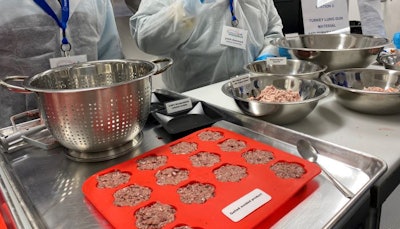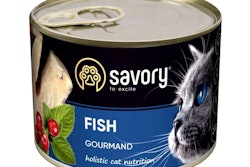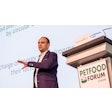
Upcycling parts of livestock animals normally sent for rendering, or even to be discarded, into pet treats can add value to both the pet food and livestock production industries, according to Charles Starkey, Ph.D., professor in the Poultry Science Department at Auburn University. He is guiding his graduate students in developing and creating such treats and offering a sustainable path to what he sees as a better financial model for all involved.
Starkey discussed their research during an event, Petsure Imaginarium, that Auburn hosted November 14-16, 2022, in partnership with Balchem, which provides ingredients and ingredient technology to the pet food and other industries. While he emphasized that rendering plays a very valuable role in the livestock production and pet food/feed supply chains, his inspiration to start the research program was to provide a financial win for poultry and other livestock producers, who normally would earn only pennies per pound for such co-products.
“Don’t get me wrong, there’s absolutely nothing wrong with rendering,” he said. “It’s just that these types of parts will bring a producer eight cents per pound via rendering, and I’m talking US$8 per pound” by upcycling them into high-value, sustainable pet treats. The research also provides a way for his students to learn about real-world, business applications of the concepts and fields they’re studying, as well as a possible new path into industry—in this case, pet food—upon graduation.
Pet treats in developmental stages
Starkey’s students have been conducting research to study various aspects of developing treats from poultry co-products such as wing tips, broiler carcass frames, woody breasts and organs, in addition to organs and other parts from beef and swine. Auburn’s poultry and meat sciences departments raise the animals as part of their research complex; the students in Starkey’s program do their research work in a state-of-the-art, small-scale poultry production plant and lab.
During the Petsure seminar, participants were able to try their hand at making some of the treats in the lab, guided by the students based on their research and its resulting formulations and processes. In most cases, the treats incorporate ground meat co-products mixed with a combination of sodium alginate (supplied by Tilley Distribution) and encapsulated calcium lactate (supplied by Balchem). This combination provides protein structure and forming properties. The mixture is then placed into silicone molds, and after setting for several hours and gelling, the treats are baked.
Starkey emphasized that the treats are in early developmental stages for research purposes; they are not commercially viable or available at this point. However, he plans to have the student embark on palatability and sensory trials soon.
To date, their published research, presented at several scientific conferences and other conferences such as Petfood Forum, has covered aspects such as texture, color, binding/structure properties and shelf life of the treats, plus the financial case for using the meat co-products in treats.
Making the case for separate processing
One study, conducted by Josha Flees, a Ph.D. student in Starkey’s program, looked at whether constructing and operating a standalone plant for processing such co-products into treats works financially. Flees was able to show a return on investment of just a few years.
This may help with the concept becoming commercially viable in the future; during discussion after the lab time, a seminar participant commented on the labor implications of separating out specific poultry, beef or swine parts from all others going to rendering at a livestock processing plant. Currently, he said, most processors would not have the labor, or see the business case, for doing so. Starkey agreed and urged all related industries to work together on solutions, for the sake of sustainability as well as financial results long-term.


















